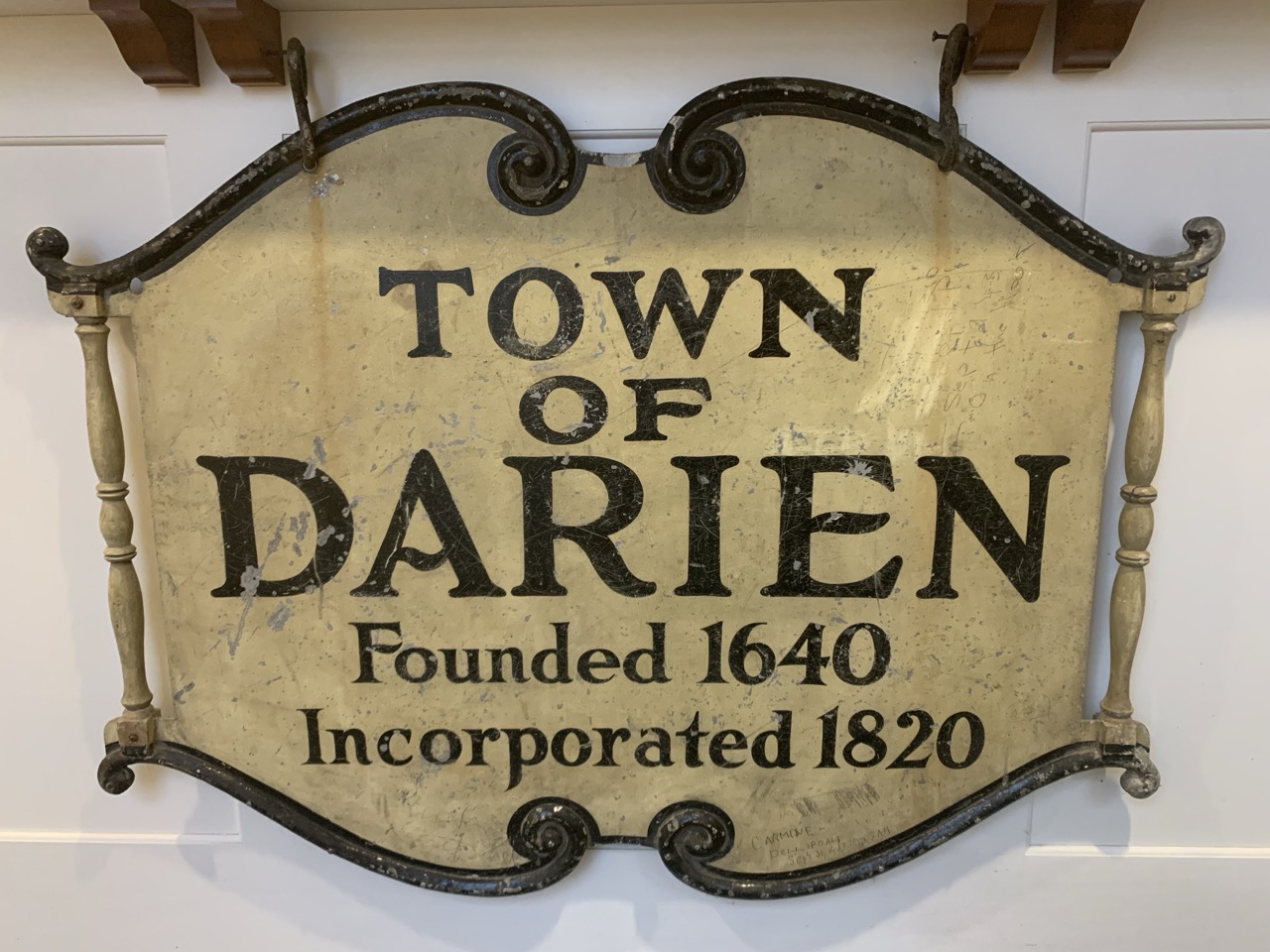Darien History
Why “Darien?” It’s Been a Long Trip…Are We There Yet?
Why “Darien?” It’s Been a Long Trip…Are We There Yet?
We all know how the conversation goes; it’s always pretty much the same, and it always ends up in the air.
“Why,” it begins, “did Thaddeus Bell choose ‘Darien’ as the name for our newly-chartered town?” ‘Darien’ was an old name for Panama, and this town joined Stamford and Norwalk just as Panama—Darien– joined North and South America. It always seems to start with that suggestion, and then go downhill from there.
We all would love to solve this puzzle…I especially would, as, after 30+ years of treading that path, I am finding it tougher to try to find where it leads. After all, we are not the only Darien in America. I wonder…might it be possible that a different Darien might hold the key to why that name would have been chosen?
As it turns out, there are six Dariens in the United States. Sounds promising…that should give us something! So we don’t tangle up cause and effect, we’ll take them in the order in which they came about:
Our earliest American Darien is a small seaport in southern Georgia, not far from what once was Spanish Florida. Around the year 1700, when that Darien was settled and named, Georgia, like most of North America, was British, and, as was often the case, Britain needed to defend its Colonial ports from its perennial enemies. This time, it had met that challenge by populating the new town with a shipload of the meanest, most pugnacious Scottish warriors it could coax out of the Highlands.
The Scots had been willing to leave home because Scotland was starving. It had not been many years since the so-called “Darien Scheme”, which was going to make Scotland rich by opening the way across Panama to connect the oceans, collapsed, taking the Scottish economy with it. The emigrants in Georgia named their new waterfront town “Darien,” in memory of their countrymen who had suffered so horribly.
But that’s not much help to us.…
Our new town, formerly the Middlesex Parish of eastern Stamford and western Norwalk, was, after several tries, approved in the Spring of 1820 by the Connecticut Legislature as a carve-off from Stamford. As the handiwork of our State Assemblyman, Thaddeus Bell, the new town’s charter was routinely drawn up by the Assembly’s clerk to include the name “Bellville.” Assemblyman Bell demurred, and without explanation, entered the name as “Darien.” Hence the mystery surrounding his choice of names.
What is not a mystery is the fact that by 1820, the westward migration of land-seeking sons and daughters of Eastern farm families had broken new soil and created new towns and villages by the hundreds in newly-accessible lands from New England to the Ohio River. The eastern section of the Erie Canal had already opened, giving market access to millions of acres of “canal lands” which were being advertised by bills posted in towns and cities all along the Eastern seaboard.
Naming so many new towns posed a challenge. British and Native American names were no longer popular…the Stamfords and Saratogas had had their day. The Classics came down off their shelves, and towns in New York became Ithaca and Attica. Albion and Macedon, Utica, Rome, Syracuse and, of course, Troy. Foreign capitals had their day, too, with Berlin and Paris, Warsaw and Moscow among the leading choices.
Often overlooked are the choices made in celebration of the newly won revolutions in Spanish America, where peasant armies under commanders like Simon Bolivar crushed the armies of Spain. The aging yeomen who had served with Washington to defeat the British all those years before, followed the war against the Spanish with more than passing interest, and are said to have been influential in rewarding the victors by giving their own towns names from South and Central America. Maine celebrated the defeat of Spain by naming one town Mexico and another one Peru. Vermont had a Peru as well, and both New York and Ohio had a Mexico and a Peru, and a Lima to go along with it.
Darien, a common name for the Isthmus of Panama, may well have been an example of that phenomenon, though Assemblyman Thaddeus Bell, a combat veteran of the American Revolution, never said why he chose it. Whatever the reason, it was a good choice. We could have been Peru.
Darien, New York, was indeed a product of the naming frenzy in Central New York. It is in Genesee County, in the heart of the Canal Lands, where it lies between the towns of Attica and Corfu. It is a quiet town of around 3,000 residents, and includes Darien Lakes State Park. Founded in 1832, it is third on the list to bear the Darien name. It is near the town of Leroy, which had been Buttermilk Falls until it was bought by New York merchant Herman Leroy, who re-named it and turned it into a flour milling center. One of Herman’s family, Captain Anson Van Horne Leroy, summered in Darien, Connecticut, where a street, Leroy Avenue, now bears the family name, and is also remembered for the Victorian Leroy mansion, which now serves the community as a handsome funeral home.
Darien, Wisconsin, lies just over the border from Illinois. It was founded in 1837 by John Bruce, Jr., and named “Bruceville.” an understandable but unfortunate choice. Three years later the name was changed to “Darien,” at the urging of several families who had emigrated to Bruceville from Darien, New York. Since 1840, Darien, Wisconsin has grown into a proud and successful community of about 1,500 residents.
Darien, Missouri, is not exactly a town, and never was. It is considered a “Place” in Dent County, in the foothills of the Ozarks a hundred miles or so from the Arkansas border. In 1888, this “unincorporated Place” was granted a post office. Its postmaster, who was a lover of John Keats’ 1816 sonnet, “On First Looking into Chapman’s Homer,” could not resist the opportunity to call the place “Darien”, the final word in the poem, which likens Keats’ sense of discovery while reading Chapman to that of the Spanish explorers who crossed Panama and first sighted the Pacific Ocean, and “Look’d at each other with a wild surmise —- Silent upon a Peak in Darien.”
The Darien, Missouri, post office was closed in 1958, but the community, still unincorporated, still exists and appears on local maps. While other “Dariens” have been linked hypothetically to the Keats poem, this Darien name seems to be the only one with a strongly accepted causality. As such, we felt it should be included here, small as it is.
The newest of our Dariens is Darien, Illinois.
The city of Darien lies about 30 miles southwest of the Chicago Loop, in an almost straight line along Interstate 55. Most of the lines out here are straight; the country is flat, and most of it has been converted from farmland since the Second World War.
After 20 years of economic hardship and global war, the pent-up demand and return of prosperity brought a wave of housing developments—big ones—which made towns that hadn’t been there before. The flat plains west of Chicago caught it all. Here’s one example:
By 1969, the presidents of the homeowners associations of four huge developments had begun to discuss merging their associations and incorporating the result into a municipality that did not have to rely on county-run services. The developments, Marion Hills, Brookhaven, Clairfield and Hinsbrook, sounded for all the world like the towns that surrounded them: Hinsdale, Willowbrook, Woodridge, Westmont and so on.
After winning a members’ vote to approve the merger by a squeaker, the executives of the four developments met with Sam Kelly, the new “mayor” of the putative municipality. In a place where all the names sounded alike, settling on a name for another new city would be a huge hurdle.
“On our trip back East,” said Mayor Kelly, “we stopped in Connecticut, and we visited a town there called Darien…it seemed like a really nice place to live.” To this day, the website of Darien, Illinois states that the name was taken from the town in Connecticut!
There are lessons to be learned from our tour of America’s Dariens. One lesson is that our Darien, the one in Connecticut, seems to be the only one that is bothered about the significance (if any) of its name. Georgia has the Scottish connection; Missouri, such as it is, is tied to Panama via the Keats poem; Illinois is named after us; Wisconsin brought the name from New York; and Darien, New York, seems to be too preoccupied with their Six Flags amusement park to dither over where their name came from (although it could have been brought by migrants from Connecticut).
The truth is, that six-letter Darien is simple, neutral, pleasant, nice, mostly meaningless, modest-sounding, perhaps even a touch romantic, and combines well with most state names. Assemblyman Bell is often reported as having explained his choice of the name Darien by replying that he “liked the sound of it.” I am sure he did, as have a lot of other people over the years. It is high time we stopped looking under the bed, and accepted Mr. Bell’s explanation.
Ken Reiss
